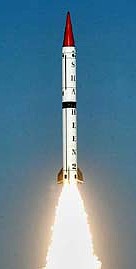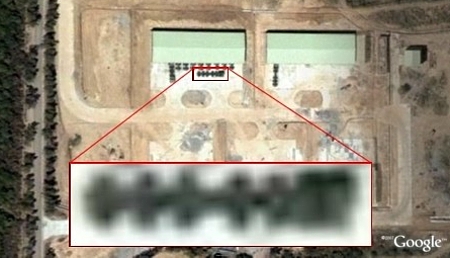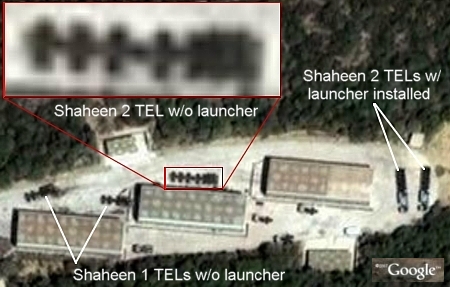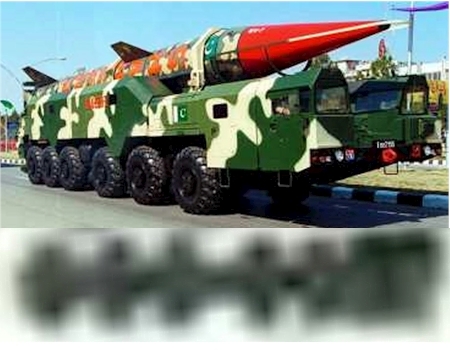 |
|
Shaheen 2 launch |
By Hans M. Kristensen
Pakistan is preparing its next-generation of nuclear-capable ballistic missile for deployment. A satellite image taken on June 5, 2005, shows what appears to be 15 Transporter Erector Launchers (TELs) for the medium-range Shaheen 2 fitting out at the National Defense Complex near Fatehjang approximately 30 kilometers southwest of Islamabad.
The vehicles were discovered as part of preparations for the latest Nuclear Notebook on Pakistani nuclear forces published in the May/June issue of the Bulletin of the Atomic Scientists. The Notebook is written by Hans M. Kristensen of the Federation of American Scientists and Robert S. Norris of the Natural Resources Defense Council.
The authors estimate that Pakistan currently has an arsenal of about 60 nuclear weapons. In the last five and a half years, Pakistan has deployed two new nuclear-capable ballistic missiles, entered the final development stages of a potentially nuclear-capable cruise missile, started construction of a new plutonium production reactor, and is close to completing a second chemical separation facility. As Pakistan completes development of two more nuclear-cable ballistic missiles and a cruise missile in the next few years, the nuclear arsenal will increase further.
| Pakistani government responds to blog:The government downplayed a report by an organization of American scientists that Pakistan is preparing its next generation nuclear-capable ballistic missile for deployment. “This is a speculative report which contains part fact and part fiction,” is how the spokesperson characterized the report.”Source: Dawn, “N-Capable Missiles,” May 11, 2007. |
The main driver for Pakistan’s nuclear modernization appears to be India’s nuclear build-up, although national prestige probably also is a factor. The two countries appear to be entering a new phase in their regional nuclear arms race with medium-range ballistic missiles gradually replacing aircraft as the backbone of their nuclear strike forces. In contrast to aircraft, ballistic missiles have a very short flight time and cannot be recalled once launched.
National Defense Complex Activities
The National Defense Complex (NDC) was established in 1993 and has since expanded into a center for the development of Pakistan’s missile force. The main facilities are spread over a 6×2 km (4×1 mile) area on a ridge, and include what appear to be administrative buildings, missile assembly halls and garages. At two locations, several large six-axle vehicles are clearly visible on the satellite image, as are several smaller four-axle vehicles.
Approximately 1.5 km (0.9 miles) northwest from the main building is a cluster of what appears to be five recently constructed garages. Parked in front or partially inside the two largest garages to the west are 11 vehicles that clearly show the characteristic six-axle design of the Shaheen 2 TEL, indicating that the launcher itself has not yet been installed (see figure 1).
|
Figure 1: Shaheen 2 TELs Awaiting Assembly |
 |
| These 11 trucks at the northern part of the National Defense Complex may be Shaheen 2 Transporter Erector Launchers (TELs) awaiting installment of missile launcher. |
The second facility is located just south of the main building and includes what may be four large assembly halls where the missile launchers are installed on the vehicles. One six-axle vehicle (as well as one outside the frame of the image show here) appears to be about to enter the hall. Outside the other end of the building are what appear to be two Shaheen 2 TELs that have completed installment of their missile launcher, thereby obscuring the axles of the vehicles. Two four-axle vehicles are also visible, which may be Shaheen 1 TELs awaiting assembly.
|
Figure 2: Shaheen 2 TELs Undergoing Assembly |
 |
| This part of the satellite image appears to show Shaheen 2 Transporter Erector Launchers (TELs) in the process of having their missile launchers installed. Possible Shaheen 1 TELs are also visible. |
It is important to stress that the satellite image is not of high enough resolution to make it possible to identify with certainty the vehicles and the buildings. But the image is good enough to determine that the large vehicles strongly resemble the six-axle Shaheen 2 TELs photographed at Pakistan Day parades. Each six-wheel vehicle is 16-17 meters long with a drivers compartment that covers the front axle (see figure 3).
|
Figure 3: Shaheen 2 Launcher |
 |
| The blurry six-axle vehicles (bottom) detected at the National Defense Complex strongly resemble the frame of the Shaheen 2 Transporter Erector Launcher (top). The front axle is not visible in the satellite image because it is covered by the drivers compartment. |
Shaping the Future (Section below updated May 10, 2007)
Although the Shaheen 2 launchers appear to be fitting out at the National Defense Complex, the missile they are intended to carry is not yet thought to be fully operational. Four test-launches of the 2,000+ km missile have been conducted since 2004, the most recent in February 2007, and the missile is probably close to becomming fully operational.
Once Shaheen 2 does become operational, it will give Pakistan the ability to target facilities across most if not all of India and hold all of India’s major cities at risk. As such Shaheen 2 will be Pakistan’s response to India’s long-awaited deployment of the Agni II missile. The race is on.
Background: Pakistan’s Nuclear Forces, 2007 | FAS Pakistan Special Weapons Guide
The FY2026 National Defense Authorization Act (NDAA) paints a picture of a Congress that is working to both protect and accelerate nuclear modernization programs while simultaneously lacking trust in the Pentagon and the Department of Energy to execute them.
While advanced Chinese language proficiency and cultural familiarity remain irreplaceable skills, they are neither necessary nor sufficient for successful open-source analysis on China’s nuclear forces.
Satellite imagery has long served as a tool for observing on-the-ground activity worldwide, and offers especially valuable insights into the operation, development, and physical features related to nuclear technology.
This report outlines a framework relying on “Cooperative Technical Means” for effective arms control verification based on remote sensing, avoiding on-site inspections but maintaining a level of transparency that allows for immediate detection of changes in nuclear posture or a significant build-up above agreed limits.